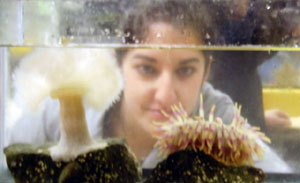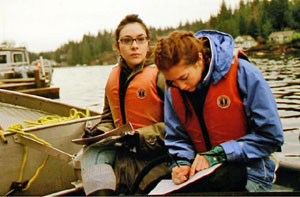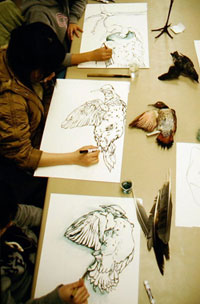Field Trips as a Means in Developing Sustained Investigations (Concentration)
by Barbara Sunday
The AP Portfolios require a Sustained Investigation (Concentration) study. This study teaches students to identify a visual problem, plan a strategy of investigation, develop a body of evolving works, and reflect upon the sequence in a written statement. It’s important for students to define their idea and show evidence of growth and discovery. Field trips are a great way for students to figure out what they want to focus on in their Sustained Investigation.
Why Take a Field Trip?
Removing students from familiar surroundings builds their powers of observation and visual curiosity. Students can use the field trip as a chance to initiate a series of related images. Such images more readily present themselves if students find and develop personal responses stimulated by a change of place.

Student observing sea anemones
Discovery through a changed viewpoint is key to the success of the field trip and to the progression of pieces in the Sustained Investigation.
Where Should You Go?
Take your students any place they can experience new imagery. This can be neighborhood back alleys, a rural village, a farm, a waterfront setting, or a science museum. Arrange an art adventure.
Prepare for and lead a tour of the place you visit. Before the trip, get students ready to record (in multiple formats) what they see in architecture, natural forms, people, signs—anything that is unfamiliar or sparks their curiosity. This triggers the ideas and forms of a Sustained Investigation
When Should We Go?

Students record a boating journey
Ideally, a field trip occurs after students have acquired art-making skills and have a need for focus, but early enough to allow time to develop ideas and produce the artwork after the field trip.
Field Trip Strategies
For some students, what they closely observe on the excursion is enough to inspire a body of work. Others may need more mentoring and support to get started. Two strategies are outlined below.
Strategy #1
Goal:
Create a personal response to the field trip “Journey” in a Sketchbook/Artists' Journal.
Method:
Students record and develop field trip observations in a sketchbook. At first, images may appear chaotic and disconnected. Students then create relationships among their ideas and images. They look for things that make visual sense when juxtaposed.
Have students combine one image with another, blending edges and layers. Sequences can develop on several pages at once. Elements of risk, change, and chance keep students alert for meaning.

Drawing on location at the Natural History museum
Encourage use of text, overprinting, and collage. Contrast is crucial to show each component in a composition.
Students discover increasingly deeper levels of meaning when they connect their personal images. This ignites the Sustained Investigation. The journey becomes the idea.

Field trip-inspired student artwork
Strategy #2
Goal:
Create site-specific work during the field trip
Method:
Make a pre-trip visit to the field trip location. This lets you plan on-site studio experiences so students can work on several pieces focused on site-specific ideas. Plan the studio activities in advance to fit the unique resources of the site. When you return to the site with your students, bring suitable media to integrate concept and technique. For example, during a forest walk, students could use leaves with watercolor, charcoal made from burned sticks, or waterproof ink and paper. Have your students take part in on-site art-making activities to capture responses to their surroundings. The imagery they initiate informs their Sustained Investigation focus.
Authored by
Barbara Sunday